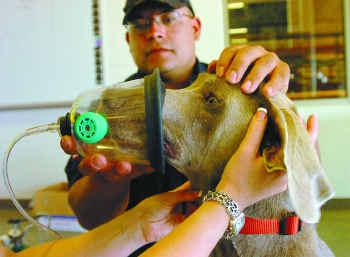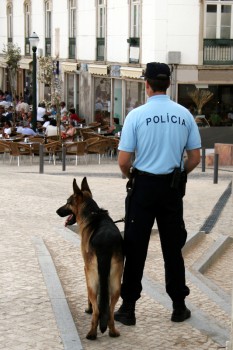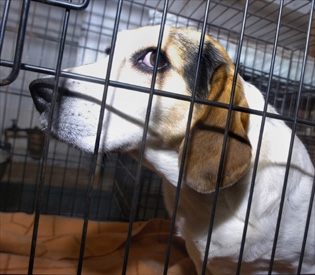We’ve all heard that a dog’s sense of smell is much better than ours, but what about the other four senses? For years, people have said that dogs only see in black and white, but it turns out that’s a wives’ tale. Dogs can actually see in a spectrum from black to green to blue to grey, as well as creams and white. In comparison, humans sees more than 7 million different shades and hues. However…
All posts by The Dog Lady
The Continuing Saga of Kayla’s DNA
If you’ve been following along, you know that I sent away my “mutt”, Kayla’s DNA to try to find out what breed(s) she is. Unfortunately, I apparently didn’t get a good enough sample the first time, so I have had to re-do the sample. Just mailed it back in today, so there’s still time to get your votes in. What’s your guess as to what she is? See her picture here and post your guess below. No prizes, just good clean fun.
Until next time,
Good day, and good dog!
Death of a Police Dog
Dog Flu
 It appears dog flu is raising its ugly head again, this time in New Jersey. According to the Star Ledger, the virus has been found in Burlington, Mercer, and Sussex Counties. There is no cure, and as many as 80% of exposed dogs will get the disease.
It appears dog flu is raising its ugly head again, this time in New Jersey. According to the Star Ledger, the virus has been found in Burlington, Mercer, and Sussex Counties. There is no cure, and as many as 80% of exposed dogs will get the disease.
Dog Bite Prevention Program
 At its annual convention in New Orleans this month, the American Veterinary Medical Association announced a new program aimed at reducing dog bites among children aged 3 – 6. Children younger than three should never be left alone with any dog, the group is quick to point out.
At its annual convention in New Orleans this month, the American Veterinary Medical Association announced a new program aimed at reducing dog bites among children aged 3 – 6. Children younger than three should never be left alone with any dog, the group is quick to point out.
According to Dr. Ilana Reisner of the University of Pennsylvania, dog bites happen when people don’t understand dog behavior. “Children are more likely to get bitten by dogs because of the way they interact with dogs.” Continue reading Dog Bite Prevention Program
Should Dogs Be Allowed at Work?
Kayla’s Dog DNA Update
 Loyal readers will remember I sent away Kayla’s DNA to see what she is made of on June 29th. I received an e-mail last week stating that my order had been received and was in process. Before the results are in, any guesses? She has the coat of a German Shepherd, but a curled tail like a Huskie or Chow. She’s just a bit bigger than my Golden Retriever. Also, she is on the aggressive side. We saw her mom, who I thought looked a lot like a Border Collie. From her picture above, what would you say?
Loyal readers will remember I sent away Kayla’s DNA to see what she is made of on June 29th. I received an e-mail last week stating that my order had been received and was in process. Before the results are in, any guesses? She has the coat of a German Shepherd, but a curled tail like a Huskie or Chow. She’s just a bit bigger than my Golden Retriever. Also, she is on the aggressive side. We saw her mom, who I thought looked a lot like a Border Collie. From her picture above, what would you say?
Saving Pets from Smoke Inhalation
 From the Dallas Morning News: What a great idea! As many as 40,000 pets are killed in fires each year, usually from smoke inhalation. The number is so high because pets, scared by the fire, smoke, and commotion, often hide from firefighters.
From the Dallas Morning News: What a great idea! As many as 40,000 pets are killed in fires each year, usually from smoke inhalation. The number is so high because pets, scared by the fire, smoke, and commotion, often hide from firefighters.
To help combat this problem, firefighters in McKinney, Texas now have access to special equipment that will fit over a dog or cat’s muzzle to administer oxygen. These kits, given to the fire department by Dog Scouts of America, Troup 119, cost about $55 each.
Keri Price Grant, fire and life safety coordinator with the McKinney Fire Department, says, “For years we just tried to use human oxygen masks. We tried to retrofit the mask to fit a dog, and that doesn’t work well. We are not a mobile veterinary care unit, and these kits are strictly for use in a fire. Our top priority is saving human beings, but in our society, many people consider their pets to be their children and members of their family.”
The kits come with three sizes of muzzle masks to fit most household pets. The Dog Scout Troop has donated 85 kits to fire departments all over the Dallas area, with a promise to resupply the disposable masks as needed.
Dog Scouts of America is a non-profit group which seeks to encourage responsible pet ownership. Two paws up to them for such a thoughtful gift!
Until next time,
Good day, and good dog!
Picture Credit:
MWD: Meapons of Wass Destruction?
No, actually MWD stands for military working dog. The US Air Force has recently shed a bit of light on the training program it uses to train dogs for everything from guard duty to explosives detection.
First, the dog must be the right breed. The Air Force most commonly uses German Shepherd and Belgian Malinois, with a slight preference for the Malinois due to its longer average lifespan. Next, the dog is evaluated for its drive or “ability to remain focused and determined to obtain a goal”, according to Staff Sgt. Manuel Garcia of the 35th Security Forces Squadron.
The dog must undergo basic training, just as airmen do, at Lackland Air Force Base in Texas. The program lasts from four to six months, depending on whether or not the dog gets held back for remedial training.
After being sent to its permanent base, the dog spends a few weeks with its new handler, learning to follow his commands. When the dog is ready, they review the basic obedience learned at Lackland, staying close to the handler and obeying his basic commands.
A few weeks later, the dog moves on to advanced obedience, where he learns to follow the same commands, even though he is off leash and at a distance from his handler. The dog also learns to crawl and roll, tactical moves he may need later.
Soon, the lessons begin to include actual work skills such as detection, attack, search, and working under the gun (literally!)
Once trained, the dog will work between 10 and 12 years, then be retired. He could be adopted, returned to Lackland to train new dogs, or be given to local police departments for further work.
A round of applause for our military working dogs! (As well as those they work with!)
Until next time,
Good day, and good dog!
Morris Animal Foundation
 The Morris Animal Foundation has been in business for 60 years, dedicated to finding animal health research. When I first read about the Foundation, I was surprised that they were worried about dogs, because I thought it was named for the cat food commercial Morris. Shows you what I know! The Foundation was established by a veterinarian named Dr. Morris, who wanted to improve the health condition of all animals.
The Morris Animal Foundation has been in business for 60 years, dedicated to finding animal health research. When I first read about the Foundation, I was surprised that they were worried about dogs, because I thought it was named for the cat food commercial Morris. Shows you what I know! The Foundation was established by a veterinarian named Dr. Morris, who wanted to improve the health condition of all animals.
Noting that cancer is the number one cause of death in dogs over the age of two, the Foundation has posted an exclusive presentation (as above + /ccexclusive) on its website featuring information and insight from leading canine cancer research centers. There is a question and answer section, facts about canine cancer, and updates on cancer research from Cornell University’s College of Veterinary Medicine. The site also has links to leading vet centers in the US and UK.
The Foundation has launched a global campaign to raise funds to cure canine cancer in the next 10 – 20 years, while providing more effective treatments in the meantime. You can learn more about the fundraising efforts here. And for those of you who are a bit suspicious of a charity you have never heard of, Charity Navigator ranks the Morris Animal Foundation as a four-star charity, the highest available rating.
Until next time,
Good day, and good dog!


